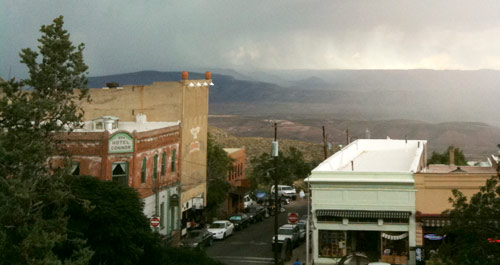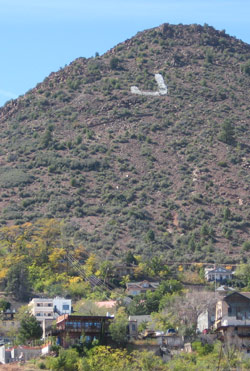Jerome is unique. No matter how much you’ve been told about the town prior to a visit, you’re in for surprises. From one visit to the next, we never know what we’ll experience in Jerome. We’ve been treated to a campy, historical film presentation, a tarantula crossing the street, costumed ladies “propositioning” our relatives to join a ghost walk, odd sensations that the place was haunted, a merchant’s talkative chicken, many shop-dogs, fabulous food and, always, friendly storekeepers. These are tame experiences compared to Jerome’s former life of mining accidents, fires, landslides, labor unrest, prostitution, gunfights and opium dens.

 Jerome possesses a colorful past, and was formerly known as “Wickedest City in the West”. Its rich mining history (mostly copper, with gold and silver) is well documented in photographs, museums and architecture throughout the town. Not so long ago prostitution was still thriving in Jerome. Today, the locals have fun keeping their history alive via plays, ghost walks and presentations of an era that came to an end in 1953.
Jerome possesses a colorful past, and was formerly known as “Wickedest City in the West”. Its rich mining history (mostly copper, with gold and silver) is well documented in photographs, museums and architecture throughout the town. Not so long ago prostitution was still thriving in Jerome. Today, the locals have fun keeping their history alive via plays, ghost walks and presentations of an era that came to an end in 1953.
Although it is not known how many Native Americans once lived in this area, it was when copper ore claims were staked in 1876 that Jerome quickly became a large, diversely populated city of 15,000. The town, once receding to 50, is presently a National Historic Registered ghost town of 400 (mostly baby boomer) inhabitants.
 Paranormal phenomena is standard conversation among visitors and locals. If you are someone who has experienced such, prepare to sense a ghostly presence here. Famous lodging*, sitting at the top of the town (5240 ft.) was once the United Verde Hospital and is famous for sightings. Several restaurants and shops also report unusual activity.
Paranormal phenomena is standard conversation among visitors and locals. If you are someone who has experienced such, prepare to sense a ghostly presence here. Famous lodging*, sitting at the top of the town (5240 ft.) was once the United Verde Hospital and is famous for sightings. Several restaurants and shops also report unusual activity.
*Lodging: http://www.jeromegrandhotel.net/
Jerome is built on the 50º slope of Cleopatra Hill. You must experience the steepness of that hill for yourself. The old buildings, in all states of repair or neglect, are known to slip about a half-inch per year. Those that have been renovated were completed with an eye to the past and are a treat to behold today. Those that are crumbling hold interesting architectural clues of their former grandness.
When you visit, be sure to allow time to visit the many art galleries and delightful shops of Jerome. This town is a treasure of unique and locally made objects.
We rarely pass through Jerome without stopping for lunch at Grapes. Although, we haven’t been there yet, we’ve heard the Flatiron Cafe is very good also.
 For historical interest, we anticipate the reopening of the Jerome State Historic Park*1. Presently, the Jerome Historical Society*2 houses the best documentation of this area. Be sure to poke your head into entries and hallways throughout the town for wonderful old photographs of Jerome history.
For historical interest, we anticipate the reopening of the Jerome State Historic Park*1. Presently, the Jerome Historical Society*2 houses the best documentation of this area. Be sure to poke your head into entries and hallways throughout the town for wonderful old photographs of Jerome history.
*1 State Park: http://azstateparks.com/Parks/JERO/
*2 Historical Society: http://www.jeromehistoricalsociety.com/
There are three ways to reach Jerome. (remember, this place is located on a steep hill) None are particularly large-vehicle-friendly, although the route up from Cottonwood AZ, via 89A, probably has the fewest hairpin turns. Another route is to come from Prescott/Prescott Valley via 89A, over Mingus Pass. A third route (and the slowest of generally rough dirt track) is to drive from Chino Valley AZ east, via Perkinsville Rd./FR318A/Jerome-Perkinsville Rd., into central Jerome. This is probably best traveled in a Jeep or other 4-wheel vehicle.